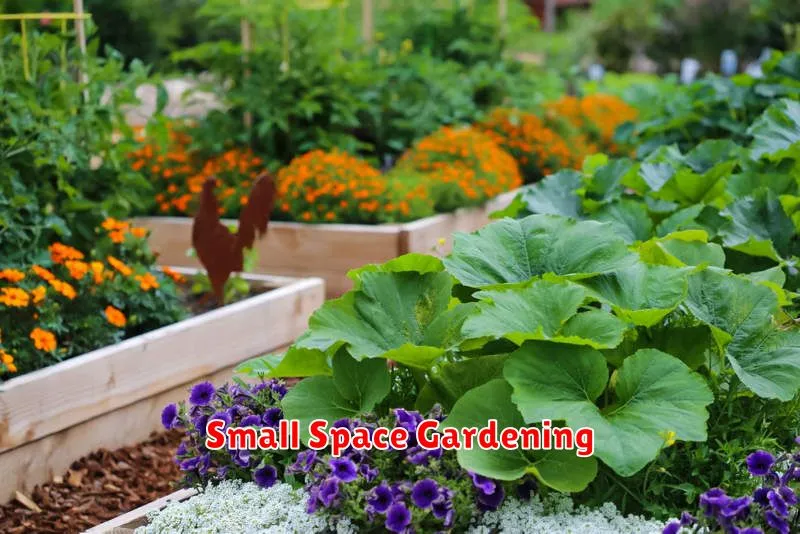Are you dreaming of a lush, green space but short on square footage? Don’t despair! This article is packed with 8 incredible vertical garden ideas perfect for even the smallest apartments or tiny homes. We’ll explore creative ways to maximize your space and bring the beauty of nature indoors, transforming your small space into a vibrant, vertical garden oasis. Get ready to discover ingenious designs using DIY vertical gardens, wall-mounted planters, and other space-saving solutions, turning your limited area into a flourishing botanical haven. Learn how to create your own indoor vertical garden today!
Succulent Vertical Garden
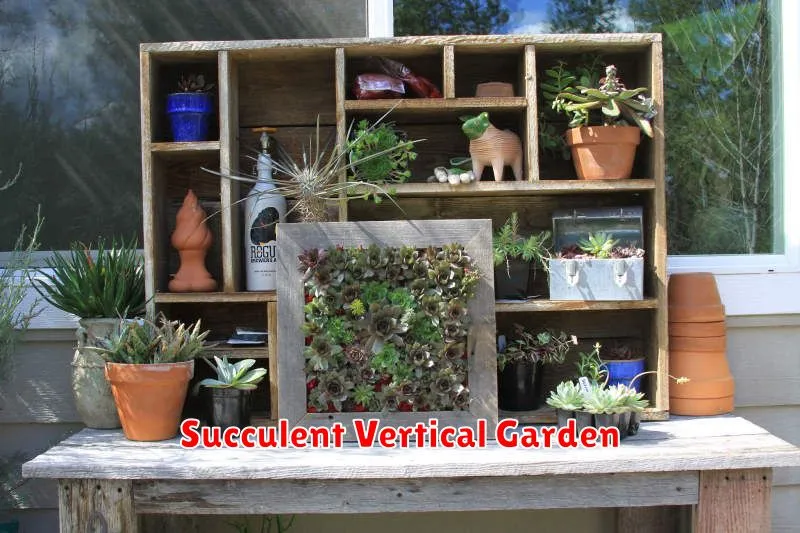
Creating a succulent vertical garden is a fantastic way to add a touch of modern, low-maintenance greenery to any space. Whether you have a small balcony, a sunny windowsill, or a large outdoor wall, a vertical succulent garden can transform your environment with its unique texture and vibrant colors.
One of the greatest advantages of choosing succulents for a vertical garden is their adaptability. They thrive in well-drained soil and require minimal watering, making them perfect for busy individuals or those new to gardening. Their diverse shapes and sizes also allow for endless creative possibilities in your design.
Choosing the right container is crucial. Consider using a repurposed pallet, a metal grid, or even a series of hanging pots. The key is ensuring adequate drainage to prevent root rot, a common problem with succulents. You can create drainage by adding a layer of gravel or pebbles at the bottom of your chosen container.
Selecting your succulents is equally important. Research different varieties to find those that suit your climate and light conditions. Think about the overall look you’re aiming for: do you prefer a mix of colors, textures, and sizes, or a more uniform design? Visit your local nursery for inspiration and advice from the experts.
Planting your succulents involves carefully placing them in the prepared container, ensuring their roots have enough space to grow. Use a well-draining succulent potting mix and avoid overwatering. You can use various methods to secure your plants, including using wire, twine, or specialized pockets designed for vertical gardens.
Once your vertical succulent garden is established, regular maintenance is minimal. Monitor the soil moisture and water only when it’s completely dry. Occasionally, you may need to prune or repot plants as they grow. With a little care, your vertical succulent garden will thrive for years to come, bringing beauty and tranquility to your home or garden.
Remember, creating a vertical succulent garden is a rewarding experience. It’s a chance to express your creativity and enjoy the beauty of nature in a unique and space-saving way. So, gather your supplies and get started on your own stunning vertical garden masterpiece!
Hanging Herb Garden
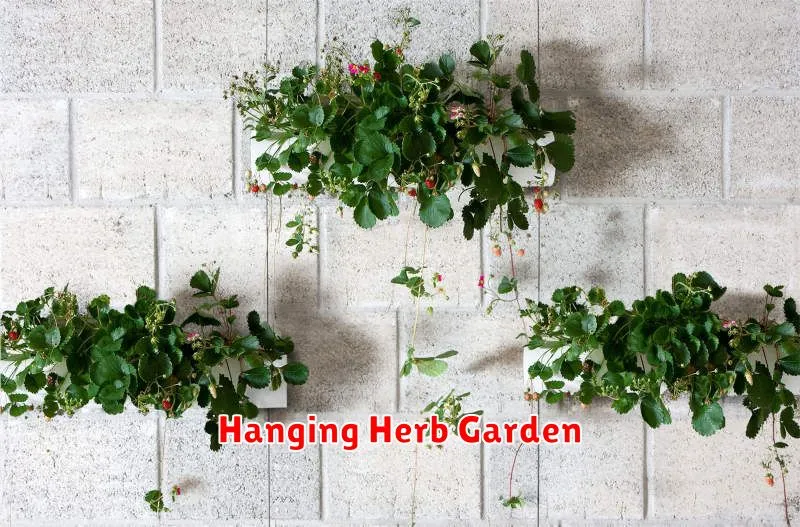
A hanging herb garden is a fantastic way to add both beauty and practicality to your kitchen or outdoor space. Whether you’re a seasoned gardener or just starting out, this vertical gardening method offers numerous advantages.
One of the biggest benefits is space saving. Perfect for smaller kitchens or apartments, hanging planters allow you to grow herbs without taking up valuable counter or floor space. You can creatively utilize otherwise unused wall space, turning a blank area into a vibrant, fragrant feature.
Easy access is another key advantage. Having your herbs hanging within reach makes cooking so much more convenient. Simply snip a sprig of fresh basil, rosemary, or thyme, directly from the plant, adding a burst of fresh flavor to your meals.
Improved air circulation is another benefit. Hanging herbs allows for better airflow around the plants, reducing the risk of fungal diseases and promoting healthy growth. This is especially beneficial in humid environments.
Aesthetic appeal is undeniable. A hanging herb garden adds a touch of elegance and charm to any setting. Choose attractive pots and planters to complement your existing décor, transforming your kitchen or patio into a miniature, aromatic oasis.
Creating your own hanging herb garden is relatively simple. You can use a variety of containers, from repurposed baskets to specialized hanging planters. Ensure you choose containers with adequate drainage to prevent root rot. Select herbs that thrive in similar conditions and enjoy the process of nurturing your little green haven.
Remember to consider the light requirements of your chosen herbs when selecting a location for your hanging garden. Most herbs need at least six hours of sunlight per day. Regular watering is also crucial, especially during dry periods. With a little care and attention, your hanging herb garden will thrive, providing you with fresh, flavorful herbs all season long.
Pallet Wall Garden
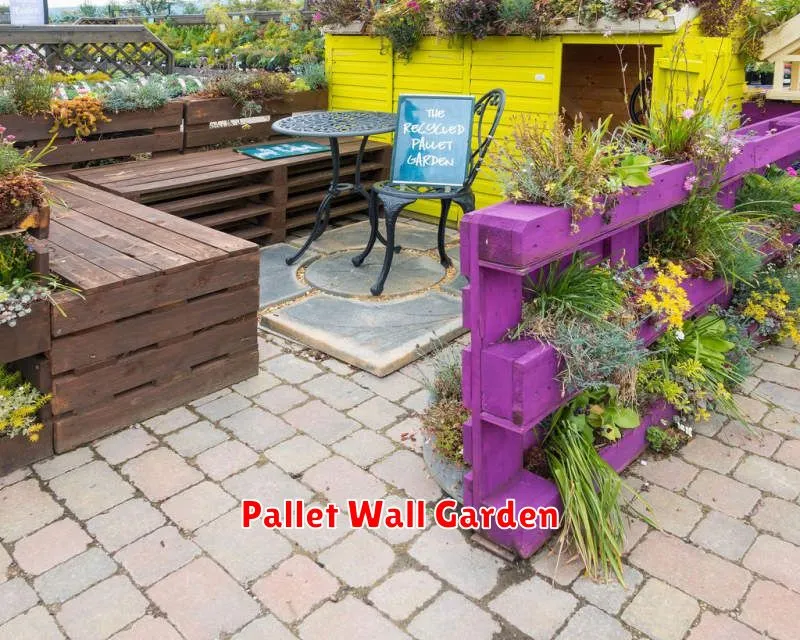
Transforming a simple pallet into a vibrant and functional wall garden is a rewarding DIY project that’s perfect for adding a touch of green to any space. This project is surprisingly easy, requires minimal materials, and offers a unique way to showcase your green thumb.
Choosing your pallet: The first step is selecting the right pallet. Look for one that’s sturdy and made of untreated wood. Inspect it carefully for any signs of damage or rot before you begin. Pressure-treated wood should be avoided, as the chemicals can be harmful to plants.
Preparation: Once you’ve chosen your pallet, give it a good clean. Remove any loose nails or splinters. You might want to sand down any rough edges for a smoother finish, and consider applying a water-resistant sealant to protect the wood and extend the life of your garden. This is especially important if you live in an area with fluctuating weather conditions.
Planting your garden: The beauty of pallet gardening is its versatility. You can use a variety of planting methods. You can use small pots or containers placed directly into the gaps, allowing for easy plant removal and replacement. Alternatively, you can line the gaps with landscape fabric and fill them with soil, creating individual planting pockets. Consider the size and root systems of your chosen plants when deciding on a method.
Plant Selection: Choose plants that thrive in similar conditions and complement each other. Succulents and herbs are popular choices for pallet gardens due to their low maintenance needs and compact sizes. However, the possibilities are endless; explore different varieties to find what suits your style and space best.
Placement: Carefully consider the placement of your pallet wall garden. Ensure it receives adequate sunlight for the plants you’ve chosen. Also, make sure it’s in a location that’s protected from harsh weather, especially strong winds and rain.
Maintenance: Regular watering and occasional fertilizing are essential to keep your pallet wall garden thriving. Monitor the moisture levels and adjust your watering schedule as needed. Regularly inspect your plants for any signs of pests or diseases and take appropriate action.
With a little creativity and effort, you can easily create a stunning and unique pallet wall garden that will bring life and beauty to your home or outdoor space. Enjoy the process and the rewarding experience of watching your garden flourish!
Modular Planter Garden
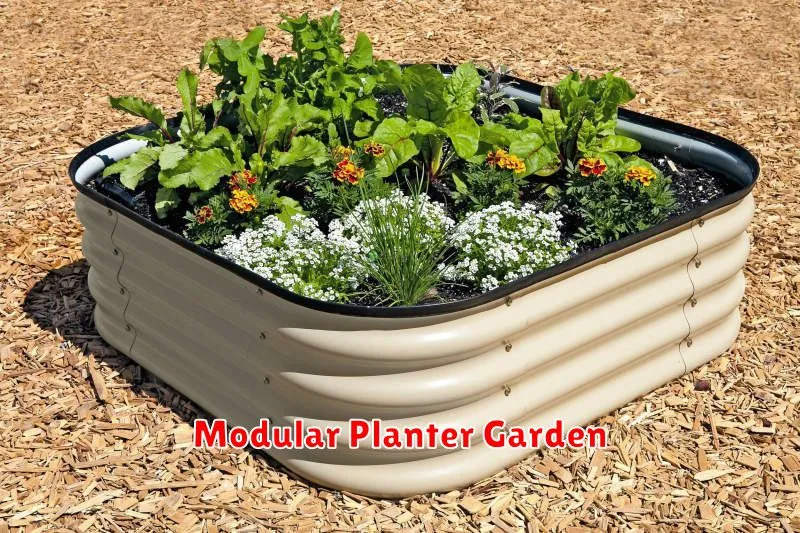
Creating a beautiful and functional garden doesn’t require a sprawling backyard. With a modular planter garden, you can cultivate a thriving green space, no matter the size of your outdoor area. This innovative approach allows for customization and flexibility, perfect for balconies, patios, or even small courtyards.
The core concept revolves around using individual, interchangeable planting modules. These modules can be arranged and rearranged in countless configurations to suit your needs and aesthetic preferences. Whether you prefer a straight line, a curved design, or a multi-tiered arrangement, the possibilities are truly endless.
Benefits of a modular planter garden are numerous. Firstly, the modularity allows for expansion. As your gardening skills and ambitions grow, you can simply add more modules to your existing setup. Secondly, it offers unparalleled flexibility. If you decide to rearrange your patio furniture, your garden can adapt seamlessly.
Materials for your modules can vary widely, depending on your style and budget. Popular choices include wood, metal, concrete, and even repurposed containers. Consider the weight, durability, and drainage capabilities of your chosen material. Remember to select materials that are weather-resistant to ensure longevity.
Designing your modular garden is a fun and creative process. Start by considering the space you have available and the types of plants you want to grow. Think about height, sunlight exposure, and water requirements. Then, experiment with different module arrangements until you find a design that works best for you.
Maintenance is relatively straightforward. Regular watering, fertilizing, and weeding are essential, just as with any garden. The modular design, however, allows for easier access to each plant, making tasks like pruning and harvesting much simpler.
In conclusion, a modular planter garden offers a stylish and practical solution for gardeners of all levels. Its flexibility, scalability, and ease of maintenance make it a perfect choice for anyone looking to create a vibrant and personalized outdoor space.
Frame-Like Vertical Garden
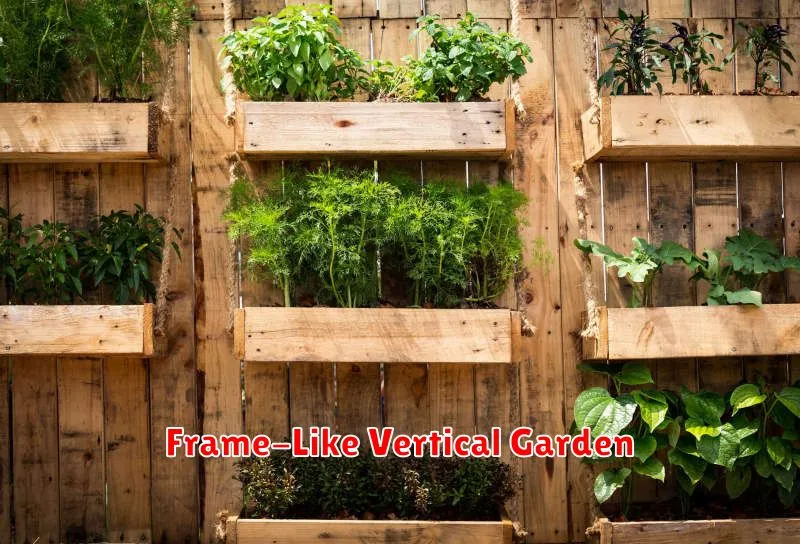
Creating a vertical garden can be a fantastic way to add greenery to your home or outdoor space, even if you’re limited on floor space. This design focuses on a frame-like structure, providing a clean and modern aesthetic while maximizing your planting area.
The frame itself can be constructed from various materials, depending on your style and budget. Reclaimed wood offers a rustic charm, while metal provides a more industrial feel. PVC piping offers a budget-friendly and easily customizable option. Consider the overall design of your space when selecting your frame material.
Planning your planting scheme is crucial. Choose plants with varying heights and textures to create visual interest. Consider the light conditions of your location – will your garden be in full sun, partial shade, or full shade? This will determine the types of plants you can successfully grow. A mix of trailing plants and upright plants will create a lush and layered effect.
Installation is relatively straightforward. Once your frame is constructed, you’ll need a suitable growing medium. Coco coir, peat moss, or a soil-less mix are all good options. Ensure your chosen medium provides adequate drainage to prevent root rot. You can then plant your chosen specimens, ensuring they have enough space to grow.
Maintenance is key to a thriving vertical garden. Regular watering is essential, but avoid overwatering, which can lead to problems. Fertilizing regularly will also promote healthy growth. Pruning may be necessary to maintain the shape and size of your plants. With proper care, your frame-like vertical garden will bring beauty and life to your surroundings for years to come.
Beyond the basics: Consider adding lighting for indoor gardens or using self-watering systems to simplify maintenance. You can even get creative with the frame design, incorporating shelves or other decorative elements.
Living Wall Art
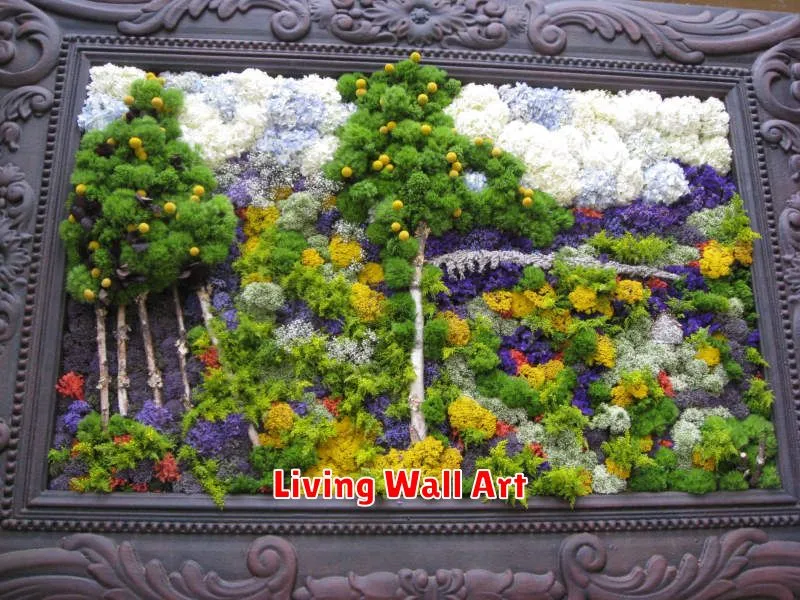
Bring the beauty of nature indoors with living wall art! This innovative and increasingly popular trend transforms blank spaces into vibrant, verdant masterpieces. Forget static paintings and prints; a living wall offers a dynamic, ever-changing display that breathes life into any room.
The benefits extend beyond aesthetics. Living walls significantly improve air quality by filtering pollutants and increasing humidity. They can also reduce noise levels and create a calming, tranquil atmosphere. Imagine the soothing sounds of a gentle waterfall integrated into your vertical garden – a true oasis of serenity within your home or office.
Designing your own living wall is surprisingly achievable. From small, self-contained units perfect for apartments to expansive, floor-to-ceiling installations in larger spaces, the options are plentiful. Consider the lighting, watering system, and the type of plants best suited to your environment and aesthetic preferences. Low-maintenance succulents and air plants are a great starting point for beginners, while experienced gardeners might explore more ambitious designs incorporating a wider variety of species.
Choosing the right plants is crucial for the long-term success of your living wall. Research plants that thrive in the available light and humidity levels. Consider factors such as their growth rate and water requirements to ensure your living art remains healthy and vibrant. Remember to regularly check your plants for signs of disease or pests and adjust your care routine as needed.
Beyond the aesthetic appeal and environmental benefits, a living wall adds a unique personal touch to your space. It’s a conversation starter, a testament to your creativity, and a constantly evolving work of art. Whether you choose a minimalist design or a lush, overflowing tapestry of greenery, a living wall offers an unparalleled way to connect with nature and enhance your living space.
Repurposed Shelving Garden
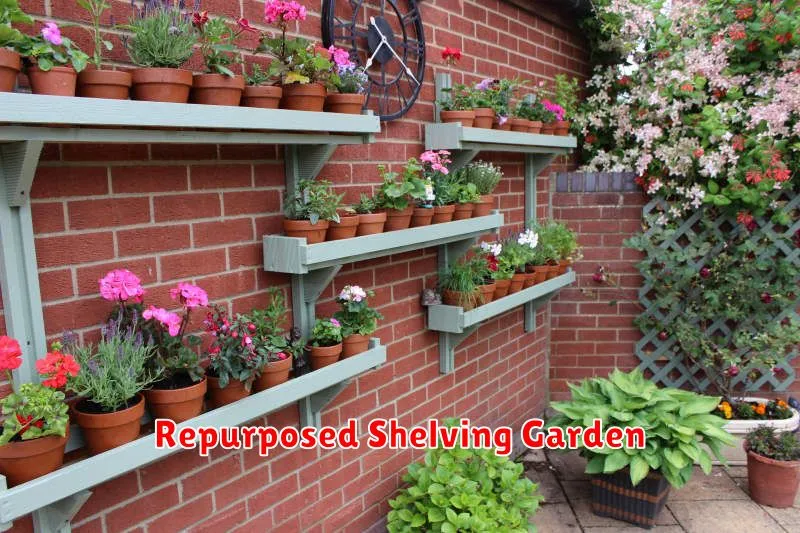
Transforming old shelving units into vibrant, vertical gardens is a fantastic way to add a touch of green to your home or outdoor space while embracing a sustainable approach to gardening. This project is perfect for those with limited space, a love for DIY, or simply a desire to breathe new life into unused items.
The beauty of this project lies in its versatility. Almost any type of shelving unit can be repurposed, from old wooden bookcases to metal shelving found at garage sales or thrift stores. The key is to assess the structural integrity of the unit to ensure it can safely support the weight of soil and plants.
Before you begin planting, you’ll need to prepare your shelves. A thorough cleaning is essential to remove any dust, dirt, or debris. If you’re using a wooden shelving unit, you might want to sand down any rough edges or apply a protective sealant to prevent water damage. For metal shelving, a simple wipe down with a damp cloth should suffice.
The next step involves choosing the right plants. Consider the amount of sunlight your shelving unit will receive and select plants that thrive in those conditions. Succulents, herbs, and small flowering plants are all excellent choices for vertical gardens. Be sure to use suitable planting containers that will fit comfortably on the shelves and prevent soil spillage.
Once your plants are in place, take some time to arrange them aesthetically. Consider varying plant heights and colors to create a visually appealing display. Remember to water your plants regularly and monitor their growth to ensure they’re receiving adequate sunlight and nutrients. With a little care and attention, your repurposed shelving garden will be a beautiful and thriving addition to your home.
This project offers a rewarding blend of creativity and sustainability, transforming something old into something new and beautiful. The possibilities are endless, allowing for personalized expression and a unique touch to any space. So, embrace your inner green thumb and get started on your own repurposed shelving garden today!
Tiered Hanging Planters
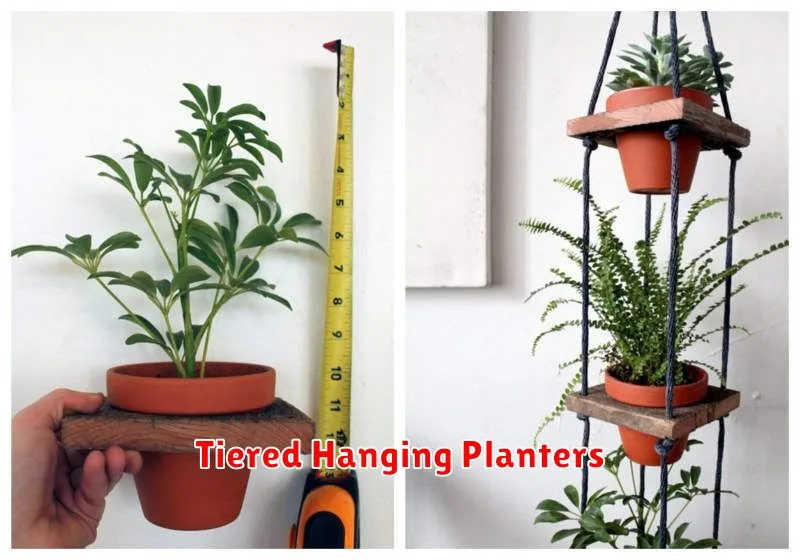
Tiered hanging planters offer a stylish and space-saving way to display your favorite plants, adding a touch of vertical gardening to any indoor or outdoor space. They come in a variety of materials, styles, and sizes, making them a versatile option for any home or garden.
One of the biggest advantages of tiered hanging planters is their space-saving design. They allow you to maximize vertical space, perfect for smaller balconies, patios, or even windowsills. Instead of spreading plants across a wide area, you can stack them vertically, creating a lush and vibrant display without sacrificing valuable floor space.
Aesthetically pleasing, tiered planters offer a visually appealing way to showcase your plants. The cascading effect of different plant heights and textures creates a dynamic and eye-catching display. You can coordinate the pots and plants to match your existing décor or create a vibrant splash of color.
Choosing the right planter depends on several factors. Consider the size and type of plants you intend to grow, as well as the available space. Measure your area to ensure the planter will fit comfortably and that your plants will have adequate room to grow. Materials range from durable plastic to more rustic materials like wood or metal, each offering a unique look and feel.
Maintenance is relatively straightforward. Regular watering is essential, ensuring that each tier receives enough moisture. You may need to adjust your watering schedule depending on the type of plant, the weather, and the material of the planter. Inspect your plants regularly for pests or diseases and address any issues promptly.
Whether you’re a seasoned gardener or just starting out, tiered hanging planters are a great way to add a touch of greenery and style to your home or garden. Their versatility, space-saving design, and aesthetic appeal make them a popular choice for enhancing any living space.

